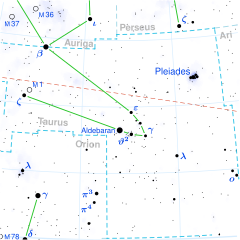| Observation data Epoch J2000.0 Equinox J2000.0 | |
|---|---|
| Constellation | Taurus |
| Right ascension | 03h 24m 48.79832s[1] |
| Declination | +09° 01′ 43.9306″[1] |
| Apparent magnitude (V) | 3.61[2] |
| Characteristics | |
| Spectral type | G6 III[3] |
| B−V color index | +0.887±0.019[2] |
| Astrometry | |
| Radial velocity (Rv) | −19.79±0.06[4] km/s |
| Proper motion (μ) | RA: −67.04 mas/yr[5] Dec.: −78.04 mas/yr[5] |
| Parallax (π) | 12.11 ± 0.87 mas[5] |
| Distance | 270 ± 20 ly (83 ± 6 pc) |
| Absolute magnitude (MV) | −1.23[6] |
| Orbit[7] | |
| Period (P) | 1654.9 d |
| Eccentricity (e) | 0.26 |
| Periastron epoch (T) | 2429974.34 JD |
| Argument of periastron (ω) (secondary) | 155.6° |
| Semi-amplitude (K1) (primary) | 4.4 km/s |
| Details[6] | |
| ο Tauri A | |
| Mass | 3.21±0.12 M☉ |
| Radius | 20.28±3.66 R☉ |
| Luminosity | 302[8] L☉ |
| Surface gravity (log g) | 2.43±0.06 cgs |
| Temperature | 5,094±15 K |
| Metallicity [Fe/H] | −0.13±0.02 dex |
| Rotational velocity (v sin i) | 3.29±0.61 km/s |
| Age | 324+39 −35 Myr |
| Other designations | |
| Database references | |
| SIMBAD | data |
ο Tauri, Latinized as Omicron Tauri, is a binary star system in the constellation Taurus, near the constellation border with Cetus. It has a yellow hue and is visible to the naked eye with an apparent visual magnitude of 3.61.[2] It is approximately 270 light years from the Sun based on parallax,[5] but is drifting closer with a radial velocity of −20 km/s.[4] As the westernmost bright point of light in Taurus, this system has the Flamsteed designation 1 Tauri; Omicron Tauri is the Bayer designation.[1]
This is a single-lined spectroscopic binary[7] system with the two components orbiting each other over a period of 4.53 years with an eccentricity of 0.263.[9] The visible component is an aging G-type giant with a stellar classification of G6 III.[3] This star has three times the mass of the Sun and 20[6]–18 times the Sun's radius. Based on the latter, interferometry-measured radius, it is rotating once every 533 days.[10] It is radiating 302[8] times the luminosity of the Sun from its photosphere at an effective temperature of 5,094 K.[6]
- ^ a b c d Cite error: The named reference
SIMBADwas invoked but never defined (see the help page). - ^ a b c Cite error: The named reference
Anderson2012was invoked but never defined (see the help page). - ^ a b Cite error: The named reference
perkinswas invoked but never defined (see the help page). - ^ a b Cite error: The named reference
GaiaDR2was invoked but never defined (see the help page). - ^ a b c Cite error: The named reference
vanLeeuwen2007was invoked but never defined (see the help page). - ^ a b c d Cite error: The named reference
Deka-Szymankiewiczwas invoked but never defined (see the help page). - ^ a b Cite error: The named reference
Pourbaix2004was invoked but never defined (see the help page). - ^ a b Cite error: The named reference
Luck2015was invoked but never defined (see the help page). - ^ Cite error: The named reference
apj125_712was invoked but never defined (see the help page). - ^ Cite error: The named reference
aaa421_241was invoked but never defined (see the help page).
